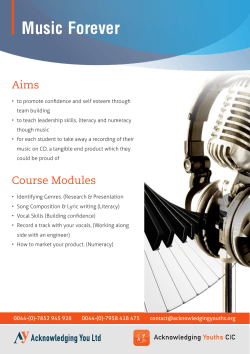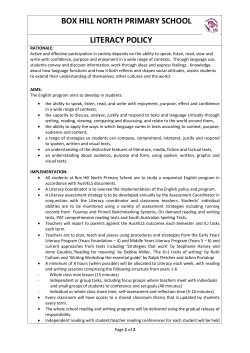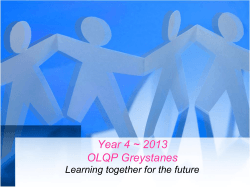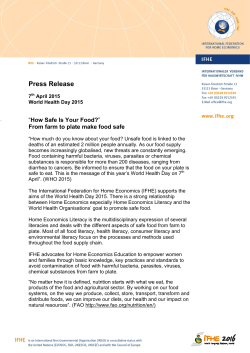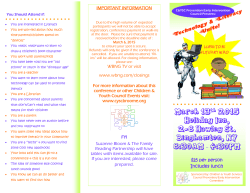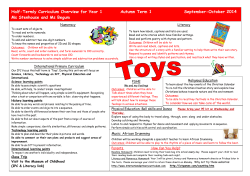
Linking Early Literacy Research and the Common
Chap ter 2 Linking Early Literacy Research and the Common Core State Standards Dorothy S. Strickland I n recent years, the literacy education of young children has received increased attention, both in the public policy arena and in the classroom. This can be attributed to a large body of research evidence showing the links between successful achievement in early literacy and later school success. This chapter connects an emergent and integrated view of early language and literacy development with the key considerations for curriculum offered by the Common Core State Standards (CCSS; National Governors Association Center for Best Practices & Council of Chief State School Officers [NGA Center & CCSSO], 2010). Connections will also be made to several current and ongoing early learning initiatives. Implications for policy, practice, and research will be offered throughout. The chapter concludes with some observations about the need for highquality professional development for all of those involved in the education of young children, so that existing and future research findings might be shared and implemented in ways that better support learning and teaching. Examining Connections Between Early Literacy Research and the CCSS Early childhood education has a long and rich history of research in the area of early literacy learning and teaching, and both policy and practice have evolved considerably due to that research. Until the late 1980s, reading readiness was the approach used by most early literacy educators. Lapp and Flood (1978) define reading readiness as the necessary level of preparation children should attain before beginning formal reading instruction, which typically began in first grade. Teale and Yokota (2000) suggest that reading readiness was pursued along two different paths by Quality Reading Instruction in the Age of Common Core Standards, edited by Susan B. Neuman and Linda B. Gambrell. © 2013 by the International Reading Association. 13 educators. Educators who were convinced that readiness was essentially a result of maturation or “neural ripeness” went down one path, whereas those who believed appropriate experiences created readiness or helped to accelerate it went down the other path. Extreme views on either side might result in some programs that involved little or no intentionally planned literacy education and others that devoted a considerable amount of time addressing the predictors in highly regimented ways. Alphabet knowledge, word recognition, vocabulary knowledge, and visual discrimination were cited as possible predictors of reading readiness. More recently, scholars have examined reading and writing (literacy) development in the everyday lives of children from their earliest years (Teale & Yokota, 2000). The concept of early literacy suggests that children begin to acquire knowledge about oral and written language long before starting school. Some basic tenets of early literacy include (a) literacy learning starts early and persists throughout life; (b) oral language is the foundation for literacy development; (c) the development of oral language and literacy is interrelated and interdependent; and (d) children’s experiences with the world and with books and print greatly influence their ability to comprehend what they read (Strickland & Riley-Ayers, 2006). While on the surface, reading readiness and early literacy approaches appear to be highly disparate, the key distinction between the two approaches may not lie in what children should know and be able to do, but in how learning occurs and is best taught. For example, Developing Early Literacy: The Report of the National Early Literacy Panel (National Institute for Literacy, 2008) confirmed that alphabet knowledge, phonological awareness, oral language, and writing/name writing demonstrated by 4- and 5-year-old children are, in fact, among the best predictors of later success in literacy achievement. In traditional readiness programs, prescribed skills in these areas are directly taught to get children “ready” to read. However, while these competencies are also included among the foundational skills listed in the CCSS (NGA Center & CCSSO, 2010, pp. 15–17), the CCSS are aligned with recent early literacy research in that they promote the integration of these skills across the language arts and content areas, with an emphasis on helping children “think with” and “respond to” a variety of types of texts. The key design considerations offered in the CCSS (NGA Center & CCSSO, 2010, p. 4) provide clarity about how these standards should be implemented. No doubt, the effectiveness of standards-based instruction will depend on how well early childhood educators understand what the standards are, what they are not, and how that knowledge best informs 14 Strickland the learning opportunities offered to young children. The CCSS design considerations suggest the following for those planning early literacy curricula: 1. An integrated model of literacy 2. A cumulative model of expectations 3. Shared responsibility for students’ literacy development 4. Research and media skills blended into the standards as a whole 5. Greater use of on-grade-level texts Each of these design considerations will be discussed in connection with early literacy instruction and the CCSS, followed by recommendations for supportive policy and practice and research possibilities. An Integrated Model of Literacy The language arts—listening, speaking, reading, and writing—should be integrated with each other and across the curriculum. Students should be asked to read or listen to texts read aloud and respond critically through discussion and in writing. Response may take the form of written or oral explanation and argument. Emphasis should be placed on critical thinking, problem solving, and collaboration with peers. Supportive policy and practice would encourage the development of a curriculum that includes a series of inquiry-based, experiential learning endeavors that focus on both the key content goals relevant to what students are expected to learn or know at the end of a unit and the key language arts and literacy goals and expectations based on the CCSS. For example, an investigation of “how plants grow” would involve thoughtful pre-planning by teachers regarding the content information children would be expected to acquire as a result of the project. Hands-on activities that involve planting seedlings and documenting their growth might be involved. At the same time, language arts activities—such as read-alouds from books about how plants grow, shared/interactive reading and writing activities, and collaborative projects that include discussions focused on the topic—would be designed to address both the content and the literacy standards in a coherent and meaningful way (Strickland, 2012). Research possibilities include an examination of the various ways in which project- and inquiry-based instruction are conducted and the extent to which they promote content knowledge, foundational skills, and higher order thinking skills as described in the CCSS. Linking Early Literacy Research and the Common Core State Standards 15 A Cumulative Model of Expectations Instruction should address grade-specific standards in tandem with the broader goals of eventual college and career readiness. This concept, sometimes referred to as spiraling, involves similar standards expressed with increasing complexity from grade to grade. Supportive policy and practice stress the importance of linking developmentally appropriate practice to grade-level standards. For example, the first College and Career Readiness (CCR) Anchor Standard for Reading listed under the heading of Key Ideas and Details states, “Read closely to determine what the text says explicitly and to make logical inferences from it; cite specific textual evidence when writing or speaking to support conclusions drawn from the text” (NGA Center & CCSSO, 2010, p. 10). At first glance, that standard may appear to be far over the heads of kindergarten and primary-grade children. However, a second look at the standard indicates that it actually does reflect the type of teacher–student interaction that is very much within the scope of “teaching for thinking” fostered by effective teachers during the early learning years. When appropriate, such teachers will pause strategically at key points during a read-aloud selection and ask, “What do you think will happen next?”; after accepting responses from one or more students, they will follow up with a “What made you think so?” prompt (if necessary) to elicit a rationale that is based on the text—that is, a response that is grounded in what the children actually heard during the read-aloud or saw in the pictures. Given such opportunities, it becomes quite obvious that even very young children can be encouraged to support their responses with evidence from the text. Moreover, they are also provided with opportunities to orally “explain” their thoughts and observations—another important element of the integration of the language arts. Research possibilities include an examination of classroom-based, developmentally appropriate practices that link to children’s attainment of and ability to demonstrate critical-thinking and problem-solving, and collaboration skills with others in ways that indicate that the skills are not only learned, but also sustained and applied appropriately in new contexts. Shared Responsibility for Students’ Literacy Development During the early years, teachers generally work in self-contained classrooms in which they are solely responsible for the instruction of a particular group of students. Collaborative planning among groups of teachers at all levels is increasingly viewed as a supportive process. 16 Strickland Teachers benefit from sharing ideas for instruction, the selection and use of materials, and the organization and management of the school day. Supportive policy and practice would include the development of a cohesive curriculum that spans prekindergarten through grade 3 (also discussed later in this chapter as a key current initiative). For example, teachers would collaborate across grade levels to examine the CCSS in conjunction with their existing standards and guidelines for instruction and assessment. Research possibilities include an examination of various models of long-term, embedded professional development that bring together teachers at the same age or grade levels and teachers at contiguous levels on a regular basis to share, plan, and reflect on curriculum and practice that support the CCSS during the early learning years. Research and Media Skills Blended Into the Standards as a Whole Critical thinking with texts in all forms of media and technology is emphasized in the CCSS. Forms may be combined for a specific goal or purpose. A balance of literary and informational texts is desirable. Supportive policy and practice would include the development of a long-term plan for the expansion of the types of texts and media to which young children are regularly exposed in the classroom. Emphasis would be placed on the acquisition of more informational texts related to planned topics of inquiry and the greater inclusion of technology to support meaningful experiences and exposure to content under study along with the application of language arts and literacy strategies. Particular emphasis would be placed on fostering teachers’ abilities to select and use a variety of media, as well as their abilities to plan for their use in ways that are integrated into the overall organization of the day. Research possibilities include an examination of various types of texts that potentially can be used for instruction, including a variety of media and text types, particularly for the uses described previously. This includes their purposeful and intentional use for the exposure to relevant content as well as the development of higher order thinking skills. Greater Use of On-Grade-Level Texts During the early years, emphasis is placed on supporting students’ abilities to become proficient in reading complex texts independently and in a variety of content areas. Effective instruction typically includes the use of developmentally appropriate complex texts for the purposes of Linking Early Literacy Research and the Common Core State Standards 17 reading aloud to students; using closely guided or interactive instruction to build background knowledge, vocabulary, and concepts; and modeling how good readers approach difficult texts. Texts representing a range of complexity should also be available for independent reading and response. Supportive policy and practice would involve providing classrooms with a variety of types and levels of texts. Teachers would be supported in their abilities to plan and implement instruction that includes (a) exposure to texts that are above students’ reading levels but within their listening comprehension levels; (b) guided, small-group reading instruction that is differentiated according to students’ reading levels; and (c) many opportunities for independent reading at students’ individual reading levels. The key is to help teachers plan instruction so that students are exposed to rich vocabulary and concepts, while at the same time progressing according to their individual abilities, with increasingly greater fluency and comprehension. Research possibilities include an investigation of how teachers are best helped to gain competence in the selection and use of various types and levels of texts for selected purposes. The purposes may be linked to specific standards or adjusted to the specific needs of children to differentiate instruction effectively. Early Learning Initiatives With Links to the CCSS: Opportunities and Challenges Upon examination, the connections between an integrated concept of early language and literacy development and the key considerations for curriculum offered by the CCSS become increasingly clear. However, an examination of how those links might be applied in the real world of emerging policies and practices deserves further attention. The following section provides brief descriptions of several current and ongoing education initiatives that are directly connected to early learning and the influence of the CCSS. Possible implications for future policy, practice, and research will be offered, with a focus on opportunities for professional development. A Cohesive Early Learning Continuum From Preschool Through Grade 3 Educators, policymakers, and the general public have become increasingly aware of the importance of the early years of schooling. Support for the early learning years is viewed as a strategic investment in the future of 18 Strickland children, particularly those considered to be at risk. Even in the face of budget crises, many states have maintained or even increased funding for prekindergarten education, in particular. The hope, of course, is to mitigate serious learning gaps that are often evidenced by grade 3 and that tend to persist throughout the later grades. It is not surprising, however, that as interest in early learning has expanded, issues of quality and sustainability have begun to surface. It has become increasingly clear that simply providing access to prekindergarten was not enough. To replicate the gains demonstrated by model programs, prekindergarten programs must be of high quality. Indeed, even early gains may dissipate unless preschool is followed by consecutive years of quality schooling in the early years (Haynes, 2008). Supportive policy and practice that builds on this initiative would include greater coordination and articulation among educators at all levels across prekindergarten to grade 3, increased coordination with education and family support agencies throughout the state and community systems, and increased support and coordination with the families involved. Research possibilities include studies of how states and districts are implementing these goals. Issues of time and intensity of professional development should be explored, and teachers’ understanding of the standards that relate to the level at which they teach as well as the levels that come before and after should be evaluated. Special attention might be given to the notion of spiraling (as described earlier in this chapter) to determine how teachers are interpreting what a standard might “look like” instructionally at different grade levels and within the same grade level in terms of differentiated instruction. Early Childhood Assessments The number of early childhood programs offered to our nation’s young children has increased dramatically in the past several decades. Many of these programs were motivated by the abundance of research evidence linking long-term student achievement to high-quality early childhood education (Barnett, 1998). As the programs have increased, so has the need for measures aimed at accountability, especially those programs receiving public funds. School systems and government agencies are asked to set goals, establish standards, track progress, analyze strengths and weaknesses in programs, and report on their achievements, with consequences for unmet goals (National Research Council, 2008). Needless to say, the development of language and literacy is invariably included as a key component of these assessments. Linking Early Literacy Research and the Common Core State Standards 19 A relatively new and important outcome of the attention given to early childhood assessment has been a growing interest in assessing children as they enter kindergarten, known as Kindergarten Early Assessment (KEA). The hope is to identify and meet the needs of children entering kindergarten to influence their development throughout the later grades and to assist, where needed, in planning for prevention and intervention. Snow (2011) reported that nearly half of the states had already instituted some form of kindergarten entry or readiness assessment by 2011. Supportive policy and practice that builds on this initiative would include a system of long-term professional development that focuses on the need for prekindergarten and kindergarten teachers to learn and exchange ideas about the collection and use of assessment data. Special emphasis would be placed on a shared understanding of how the learning environment can support or restrict children’s development and how this is linked to the early learning standards that guide teachers’ efforts. Based on the work of the National Early Childhood Accountability Task Force, Schultz (2008) outlines a series of helpful suggestions for developing a comprehensive assessment system for prekindergarten through grade 3, including a call for states to take steps to align standards, curricula, and assessments; build the capacity to share data; and support the study and use of assessment information across these grade levels (p. 10). Research possibilities include an examination of what should be measured, how it should be measured, and what types of assessments or combinations of assessment types should be used. The development of research-based models of professional development that serve both new and experienced teachers is needed. Reading by Grade 3 Many in the field of early literacy have acknowledged the importance of reading to learn, even in the earliest years, as students are read to from informational books and encouraged to discuss ideas and information about topics of interest and importance to them. Likewise, the CCSS encourage the integration of content with language and literacy from the earliest years. The need for children to gain sufficient competency in reading during the primary grades in order to comprehend a variety of types of texts for a variety of purposes throughout the middle grades and beyond is well established among educators and confirmed by the research. A recent study on this topic by Hernandez (2011) serves as a reminder that the literacy achievement gap starts early and persists throughout the grades. Key findings of the study include the following: (a) one in 20 Strickland six children who are not reading proficiently in third grade do not graduate from high school on time, a rate four times greater than that for proficient readers; (b) the rates are highest for the low, below-basic readers; (c) 23% of these children drop out or fail to finish high school on time, compared with 9% of children with basic reading skills and 4% of proficient readers; and (d) graduation rates for black and Hispanic students who are not proficient readers by third grade lag far behind those for white students with the same reading skills. Supportive policy and practice that builds on this initiative would include greater availability of high-quality prekindergarten programs; greater attention to the alignment of curriculum, standards, and instruction across prekindergarten through grade 3; higher standards for early childhood teachers and improved professional development; and improved school–family partnerships. A clear focus of the professional development would involve promoting teacher awareness and recognition that reading comprehension largely depends on the background knowledge a reader brings to the text to make sense of it. Indeed, even the decoding of print involves going beyond sound and symbol relationships to the use of contextual clues involving semantics and syntax. This is particularly important in situations where well-meaning teachers, who work with children considered to be at risk, may mistakenly focus on isolated skills alone in the hope that comprehension will automatically follow. Research possibilities include the development of models of early literacy instruction that focus on broadening the background knowledge of children along with their literacy skills. This is exceedingly important in situations where children may lack the breadth and depth of background experiences generally expected of most children their age. Technology and Early Education It has already been noted that the CCSS emphasize critical thinking with texts in all forms of media and technology. The use of technology as a tool for learning and teaching and the media habits of young children have become growing sources of interest among educators, researchers, and those in the media industry. A study by the Joan Ganz Cooney Center at the Sesame Street Workshop indicates that today’s young children have more access to all kinds of digital media and are spending more time during the day with them than ever before (Gutnick, Robb, Takeuchi, & Kotler, 2011). Additional findings include the following: (a) television continues to exert a strong hold over young children, who spend more time with this medium than any other; (b) access to newer digital technologies Linking Early Literacy Research and the Common Core State Standards 21 is largely dependent on family income; (c) lower income Hispanic and African American children consume far more media than their middle class and white counterparts; (d) children appear to shift their digital media habits around age 8 as their awareness of the wide world of media grows; (e) mobile media appears to be the growing choice of young children as they prefer to use their media on the go (p. 5). Implications and cautions about the use of technology in early childhood education settings were addressed in a joint position statement by the National Association for the Education of Young Children and the Fred Rogers Center for Early Learning and Children’s Media (2012). The report contains several key messages to early childhood teachers: (a) when used intentionally and appropriately, technology is an effective tool to support learning and development; (b) it is important to limit children’s use of technology and media; and (c) teachers must ensure equal access to technology and model good digital citizenship (Parikh, 2012). Supportive policy and practice that builds on this initiative should include a commitment to intensive, ongoing professional development that provides teachers with the information and resources they need to be able to select appropriate technology and integrate its use into the curriculum. The selection of technology for use with infants and toddlers should receive special attention. Research possibilities include investigations of how educators might be helped to better understand how young children use and learn with technology and identify short- and long-term effects. Also, there is a need to help teachers better plan for and integrate technology into classroom routines in ways that serve curriculum and instruction. Educator Evaluation Throughout the United States, numerous efforts are underway to improve educator evaluation systems at the state and local levels. Much of that effort has focused on teachers and with good reason. Research indicates a teacher’s contribution to student learning matters more than any other single factor, including class size, school size, and the quality of after-school programs (Rivkin, Hashek, & Kain, 2005). Obviously, the ultimate goal of educator evaluation, whether it focuses on teachers or school leaders, is to improve teaching and learning for children. In public school systems, all teachers in the early learning continuum, from prekindergarten through grade 3, are subject to an evaluation system, and that process is inevitably linked to both standards and assessment. Some have suggested that today’s early education system is weakened by discrepancies between standards and measurement tools used for 22 Strickland K–12 teachers and those that are used for professionals in child care and prekindergarten programs. The use of the same observation tools across prekindergarten and K–12 settings would help to bridge this gap (Guernsey & Ochshorn, 2011). Virtually all models used for measuring teacher effectiveness include many of the teacher competencies discussed earlier in this chapter. For example, a teacher’s knowledge and application of standards-based practice will, no doubt, be subject to the scrutiny of evaluators. The use of developmentally appropriate instructional practices and assessment procedures will also be examined. According to Goe (2011), three major areas of teacher effectiveness are generally covered: 1. Evidence of growth in student learning and competency. This may include the kinds of classroom-based measures discussed earlier in this chapter. 2. Evidence of instructional quality. This includes classroom observations, an examination of lesson plans, and evidence of the documentation of student learning, such as portfolios. 3. Evidence of professional responsibility. This may include reports by administrators and supervisors as well as parent surveys. Supportive policy and practice that builds on this initiative would involve a deliberate attempt to provide an environment in which teachers and administrators view the evaluation process as one that is fair and thoughtfully designed with the ultimate goal to improve the quality of teaching and learning. This includes the use of evaluation information to plan ongoing professional development that supports teachers’ abilities and needs and the improvement of the evaluation competencies of those who observe and assess various aspects of teacher practice. Research possibilities include pilot projects that involve teachers, administrators, and supervisors in an examination of existing practices and the development or the adoption of new models of educator effectiveness that fit their needs. Special emphasis should be given to examinations of the validity and reliability of existing teacher observation tools in a variety of settings with children of various backgrounds. Summary and Implications Upon reflection, it is clear that all of the elements discussed in this chapter are linked with each other and with the CCSS. Planning a cohesive early learning continuum from preschool through grade 3, using corresponding Linking Early Literacy Research and the Common Core State Standards 23 assessments that help to inform that process, and dedicating appropriate attention to fostering high-quality learning and teaching will all be essential to the mix. Research that looks not only at outcomes but also to the processes that led to those outcomes is required. Throughout the literature, quality appears to be the operative word. Research that identifies valid indicators of high-quality early literacy education while simultaneously assisting educators and policymakers to recognize and support those indicators will be critical. Try Thi s! • Before reading Gail Gibbons’s Fire! Fire! to students, bring in a smoke detector. Press the test button to make the detector sound its alarm. Then, ask students what the sound means. After listing their suggestions on a whiteboard or chalkboard, read Fire! Fire! Finally, have students check their predictions of what happens when a smoke detector’s alarm sounds against details from the text. • I n contemplation of reading Claire Liewellyn’s Earthworms, have students go outside to search for earthworms by digging up soil and placing soil and earthworms in a plastic container. Then, once back in the classroom, ask the students questions about their newly found earthworms that require students to use various text features (e.g., heading, table of contents, glossary, index). For example, you could ask them, “Where is the earthworm’s mouth?” To get the answer, students should open the book’s index and turn to the page where the information is found. Discussion Questions 1. S trickland lists five CCSS design considerations for the curriculum. What are the five considerations, and how do they impact teachers’ classrooms? 2. Strickland discusses the components of a cohesive early learning continuum for preschool through third grade. How are these components linked to CCSS? 3. H ernandez’s (2011) report Double Jeopardy reminds us that literacy achievement begins early in students’ academic careers and extends at least through high school. Given this fact, how do the CCSS attempt to address literacy achievement in all grades? 24 Strickland R e f e r e nc e s Barnett, W.S. (1998). Long-term effects on cognitive development and school success. In W.S. Barnett & S.S. Boocock (Eds.), Early care and education for children in poverty: Promise, programs, and long-term results (pp. 11–44). Albany: State University of New York Press. Goe, L. (2011, March). Evaluating teacher and principal effectiveness. Paper presented at the Legislative Conference, Council of Chief State School Officers Legislative Conference, Washington, DC. Guernsey, L., & Ochshorn, S. (2011). Watching teachers work: Using observation tools to promote effective teaching in the early years and early grades (Policy paper). Washington, DC: The New America Foundation. Gutnick, A.L., Robb, M., Takeuchi, L., & Kotler, J. (2011). Always connected: The new digital media habits of children. New York: The Joan Ganz Cooney Center Sesame Workshop. Haynes, M. (2008, June). Building state early learning systems: Lessons and results from NASBE’s Early Childhood Education Network. The State Education Standard, 13–16. Hernandez, D.J. (2011). Double jeopardy: How third-grade reading skills and poverty influence high school graduation. Baltimore: Annie E. Casey Foundation. Lapp, D., & Flood, J. (1978). Teaching reading to every child. New York: Macmillan. National Association for the Education of Young Children & Fred Rogers Center for Early Learning and Children’s Media. (2012). Technology and interactive media as tools in early childhood programs serving children from birth through age 8 (Joint position statement). Washington, DC; Latrobe, PA: Authors. National Governors Association Center for Best Practices & Council of Chief State School Officers. (2010). Common Core State Standards for English language arts and literacy in history/social studies, science, and technical subjects. Washington, DC: Authors. Retrieved from www.core standards.org/assets/CCSSI_ELA%20 Standards.pdf National Institute for Literacy. (2008). Developing early literacy: Report of the National Early Literacy Panel. Washington, DC: Author. National Research Council. (2008). Early childhood assessment: Why, what, and how? Report of the National Research Council of the National Academies. Washington, DC: National Academies Press. Parikh, M. (2012). Technology and young children: New tools and strategies for young learners. Young Children, 67(3), 10–11. Rivkin, S.G., Hashek, E.A., & Kain, J.F. (2005). Teachers, schools, and academic achievement. Econometrica, 73(2), 417–458. doi:10.1111/j.1468-0262.2005.00584.x Schultz, T. (2008, June). Tackling PK-3 assessment & accountability challenges: Guidance from the National Early Childhood Accountability Task Force. The State Education Standard, 4–11. Snow, K. (2011). Developing kindergarten readiness and other large-scale assessment systems: Necessary considerations in the assessment of young children. Washington, DC: National Association for the Education of Young Children. Strickland, D.S. (2012, February/March). Planning curriculum to meet the common core state standards. Reading Today, 29(4), 25–26. Strickland, D.S., & Riley-Ayers, S. (2006). Early literacy: Policy and practice in the preschool years (Report #10). New Brunswick, NJ: National Institute for Early Education Research. Teale, W., & Yokota, J. (2000). Beginning reading and writing: Perspectives on instruction. In D.S. Strickland & L.M. Morrow (Eds.), Beginning reading and writing (pp. 3–21). Newark, DE: International Reading Association; New York: Teachers College Press. Linking Early Literacy Research and the Common Core State Standards 25
© Copyright 2025
